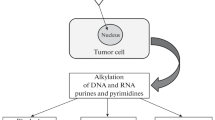Summary
The influence of different doses of the hydrophilic sarcosine- or prolinedithiocarbamate on the chemotherapeutic efficacy of doxorubicin, teniposide, methotrexate, mitoxantrone or cyclohexylchlorethylnitrosourea was evaluated in female B6D2F1 mice bearing leukemia L1210, implanted intraperitoneally. The simultaneous administration of these dithiocarbamates and the drugs used induced no increase of the therapeutic efficacy of the combinations compared to the corresponding dose of the drug and simultaneously applied saline. The results indicate that the subcutaneous pretreatment with sarcosine- or prolinedithiocarbamate increased the therapeutic efficacy of the drugs used compared to the corresponding monotherapy, in which saline was applied in the same interval as the dithiocarbamate and the antineoplastic agents. Sarcosine- or prolinedithiocarbamate applied alone did not influence leukemia L1210. The increase of the efficacy of the drugs used by sequential combination with sarcosine- or prolinedithiocarbamate seems to be influenced predominantly by diminishing the toxicity as well as by modulating the chemotherapeutic action.
Similar content being viewed by others
Abbreviations
- DDTC:
-
diethyldithiocarbamate
- SDTC:
-
sarcosinedithiocarbamate
- PDTC:
-
prolinedithiocarbamate
- CCNU:
-
cyclohexylchloroethylnitrosourea
References
Bodenner DL, Dedon PC, Keng PC, Katz JC, Borch RF (1986) Selective protection against cis-diaminedichloroplatinum(II)-induced toxicity in kidney, gut and bone marrow by diethyldithiocarbamate. Cancer Res 46:2751–2755
Borch RF, Pleasants ME (1979) Inhibition of cis-platinum nephrotoxicity by diethyldithiocarbamate rescue in a rat model. Proc Natl Acad Sci USA 76:6611–6614
Borch RF, Katz JC, Lieder PH, Pleasants ME (1980) Effect of diethyldithiocarbamate rescue on tumor response to cis platinum in a rat model. Proc Natl Acad Sci USA 77:5441–5444
Evans RG, Wheatly C, Engel C, Nielsen J, Ciborowsku LJ (1984) Modification of the bone marrow toxitiy of cis-diaminedichloroplatinum (II) in mice by diethyldithiocarbamate. Cancer Res 44:3686–3690
Frank N, Bertram B, Scherf HR, Wiessler M (1990) Influence of dithiocarbamates on the metabolism and toxicity ofN-nitrosodimethylamine in rats. Carcinogenesis 11:199–203
Goldstein BD, Rozen MG, Quintavalla JC, Amoruso MA (1979) Decrease in mouse lung and liver glutathione peroxidase activity and potentiation of the lethal effects of ozone and paraquat by the Superoxide dismutase inhibitor diethyldithiocarbamate. Biochem Pharmacol 28:27–30
Gringeri A, Keng PC, Borch R (1988) Diethyldithiocarbamate inhibition of murine bone marrow toxicity caused bycis-diaminedichloroplatinum (II) or diamine (1,1-cyclobutanedicarboxylato)platinium (II). Cancer Res 48:5708–5712
Howell JMC, Ishmael J, Ewbank R, Blakemore WF (1970) Changes in the central nervous system of lambs following the administration of sodium diethyldithiocarbamate. Acta Neuropathol (Berl) 15:197–207
Miller GE, Zemaitis MA, Greene FE (1983) Mechanisms of diethyldithiocarbamate-induced loss of cytochrome P 450 from rat liver. Biochem Pharmacol 32:2433–2442
Mitchell DY, Petersen DR (1987) The oxidation of alpha-beta unsaturated aldehydic products of lipid peroxidation by rat liver aldehyde dehydrogenase. Toxicol Appl Pharmacol 87:403–410
Pannaccinelli IM, Lerza RA, Bogliolo GV, Mencoboni MP, Saviane AG (1989) Effect of diethyldithiocarbamate on toxicity of doxorubicin, cyclophosphamide andcis-diaminedichloroplatinum (II) on mice haemopoetic progenitor cells. Br J Cancer 59:371–374
Reisinger EC, Kern P, Ernst M, Bock P, Flad HD, Dietrich M (1990) Inhibition of HIV progression by dithiocarb. Lancet 335:679–682
Sunderman FW (1964) Nickel and copper mobilization by sodium diethyldithiocarbamate. J New Drugs 4:154–161
Sunderman FW, Sunderman RW (1958) Nickel poisoning. VIII. Dithiocarbamate, a new therapeutic agent for persons exposed to nickel carbonyl. Am J Med Sci 236:26–31
Sunderman FW, Zahario O, Reid MC, Belleveau JF, O'Leary GP Jr, Griffin H (1984) Effects of diethylcarbamate and nickel chloride on glutathione and trace metal concentrations in rat liver. Toxicology 32:11–21
Trombetta LD, Toulon M, Jamall JS (1988) Protective effects of glutathion on diethyldithiocarbamate (DDC) cytotoxicity: a possible mechanism. Toxicol Appl Pharmacol 93:154–164
Author information
Authors and Affiliations
Additional information
Dedicated to Professor Dr. Dietrich Schmähl on the occasion of his 65th birthday
The support of the study by the Deutsche Krebshilfe is gratefully acknowledged
Rights and permissions
About this article
Cite this article
Osswald, H., Frank, N. Sacrosine- and prolinedithiocarbamate pretreatment increases the therapeutic efficacy of doxorubicin, methotrexate, teniposide, mitoxantrone or cyclohexylchloroethylnitrosourea in leukemia L1210. J Cancer Res Clin Oncol 116, 448–452 (1990). https://doi.org/10.1007/BF01612992
Received:
Accepted:
Issue Date:
DOI: https://doi.org/10.1007/BF01612992



